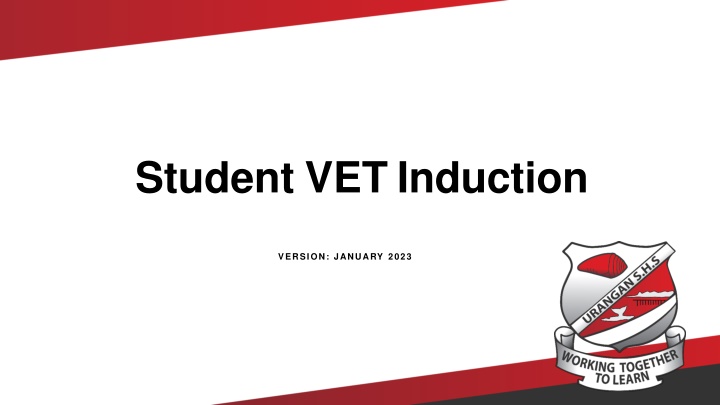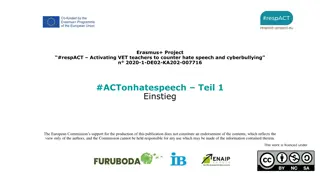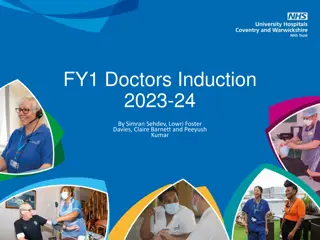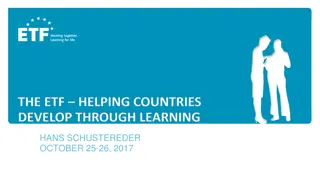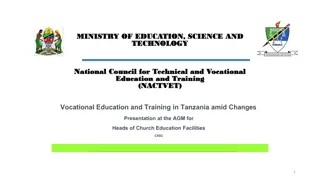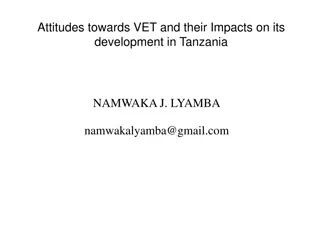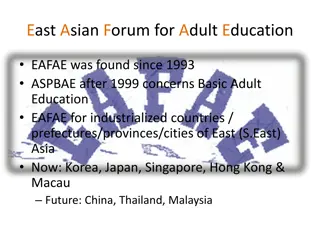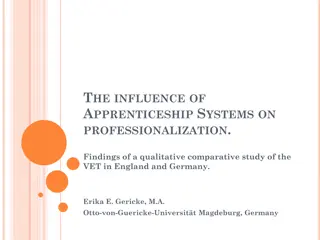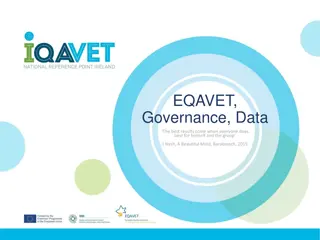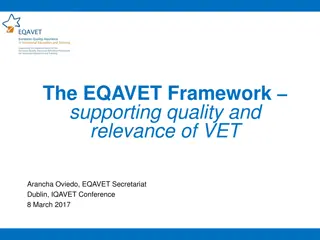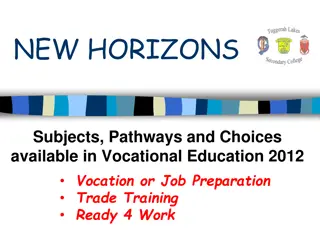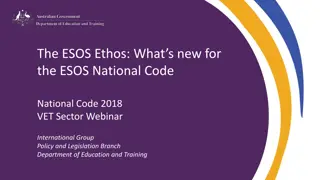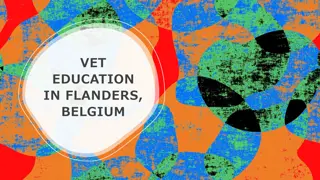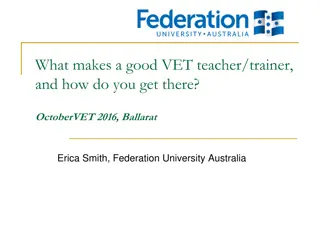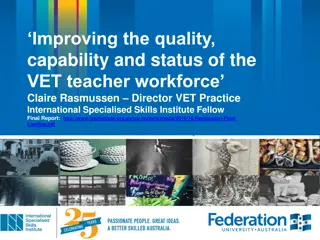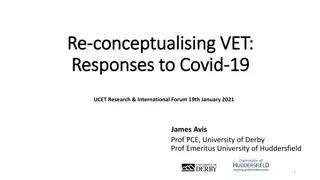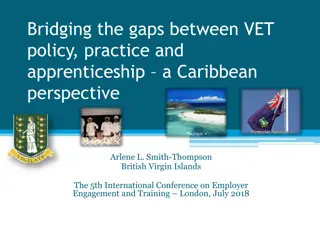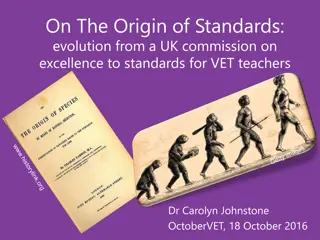Student VET Induction - Vocational Education and Training Overview
Vocational Education and Training (VET) occurs in Registered Training Organisations, focusing on workplace relevance. Training packages set industry standards and qualifications. Competency in VET is the ability to consistently apply knowledge and skills to industry standards, making individuals employable. Unlike traditional subjects, competency requires full proficiency. Assessment methods in VET can include written tasks, ensuring readiness for the workplace.
Download Presentation

Please find below an Image/Link to download the presentation.
The content on the website is provided AS IS for your information and personal use only. It may not be sold, licensed, or shared on other websites without obtaining consent from the author.If you encounter any issues during the download, it is possible that the publisher has removed the file from their server.
You are allowed to download the files provided on this website for personal or commercial use, subject to the condition that they are used lawfully. All files are the property of their respective owners.
The content on the website is provided AS IS for your information and personal use only. It may not be sold, licensed, or shared on other websites without obtaining consent from the author.
E N D
Presentation Transcript
Student VET Induction VERSION: JANUARY 2023
What is VET? Vocational Education and Training Education that occurs in Registered Training Organisations (RTOs) and Focuses on relevance to the workplace Traditionally, takes place in TAFEs or other Registered Training Organisations Inspiring growth, positive well-being and quality outcomes for all
Training Packages Atraining package is a set of nationally endorsed standards and qualifications for recognising and assessing people s skills in a specific industry, industry sector or enterprise Presents the required skills and pre-requisite knowledge to be industry ready Training packages describe the skills and knowledge that individuals need to perform effectively in the workplace Teachers and trainers develop learning strategies the how depending on learners needs, abilities and circumstances to ensure they show competency
What is competency? Competency is a skill and knowledge demonstrated to a standard that is expected by industry To be competent, you need to consistently apply your knowledge and skills to successfully complete work activities in a range of situations to the standard of performance expected in the workplace Competence shows that you are industry ready this makes you employable Competence is the standard expected by industry, not school you need to make the leap!
How is competency different to your other subjects? Think about the plane you want to be flying in when you are going on holidays. Do you want the pilot to be able to land the plane successfully 80% of the time or know 80% about flying the plane successfully? In most subjects you can achieve 80% or greater and achieve an A . To be competent, you must be able to show that you can do the task under a variety of circumstances to an industry standard this is what being competent is all about. NO you want him/her to land that plane successfully every time. That s how we want you to leave the course knowing that you can complete every aspect 100%. Inspiring growth, positive well-being and quality outcomes for all
How you will be assessed? You will be assessed in a variety of ways which may include any of the following: Written tasks If you need further information, see your VETTeacher, RTO Manager or HOD Observation Portfolio of work Oral questioning
What is RPL? Recognition of Prior Learning allows you to have the skills that you already possess recognised and credit recorded in order to fast-track through your course Evidence of prior skills may be provided by: Third party evidence (e.g. reports or testimonials) On-the-job training Work samples or annotated photographic evidence Certificates
How does the study of VET contribute to your QCE? Your QCE is achieved when you have banked 20 credit points and is made up of: Subject semester units VET qualifications Numeracy & Literacy components Core requirements If you need further information, see HOD Senior School This information is stored in your learning account. You can access this with your LUI Number through the myQCE Portal.
Banking of credits In Years 10, 11 & 12, if you study: Certificate I qualification bank 2 - 3 credits Certificate II qualification - bank up to 4 credits Certificate III qualification bank 5 - 8 credits QCE credit points can only be banked for new learning. 90% new learning is required for full QCE credits
Banking credits Partial completion If you successfully complete some of the competencies in a Certificate II or III qualification, you will receive partial credits for what you have completed. For example: if you successfully complete half of the units of competency in a Certificate II qualification, you will bank 2 of the 4 credits available for that course.
Pathways Inspiring growth, positive well-being and quality outcomes for all
What is expected of a Level I Learner: Undertake defined routine activities Identify and report simple issues and problems Apply basic knowledge and skills to demonstrate autonomy in highly structured and stable contexts and within narrow parameters
What is expected of a Level II Learner: Demonstrate basic operational knowledge in a moderate range of areas Apply a defined range of skills Apply known solutions to a limited range of predictable problems Perform a range of tasks where choice between a limited range of options is required Assess and record information from a variety of sources Take limited responsibility for your own outputs in work and learning
What is expected of a Level III Learner: Demonstrate knowledge in a specific area of work Select and apply a specialised range of skills Provide and apply solutions to predictable and unpredictable problems Perform routine tasks Assess and record information from a variety of sources Take limited responsibility in known and stable contexts within established parameters
Foundation Skills Foundation skills cover the key skills that underpin successful participation in society, including work. These skills are listed in: Australian Core Skills Framework (ACSF) Core Skills for Work Framework (CSfWF) Foundation skills are included in all updated training packages.
Foundation Skills CORE SKILLS FOR WORK AUSTRALIAN CORE SKILLS FRAMEWORK Learning Reading Writing Oral communication Numeracy Digital literacy Navigate the world of work Interact with others Get the work done
Transference of skills You may not ever choose to work in your chosen VETArea, however many of the employability / foundation skills are able to be transferred to any workplace. Completion of VET study also allows you to demonstrate commitment and perseverance both traits that would impress any employer.
Responsibility for tracking competency Who will gain benefit by you completing these certificate qualifications? YOU WILL Who will develop employability skills making you an attractive employment prospect at the end of Year 12? YOU WILL Who needs to take responsibility for completion of the course by the end of Year 10 or 12? YOU DO
Reporting and Results Rated Competent or Not Competent at the end of the course and for each Competency Report card: No results not criteria based (A, B, C, D, E) Competency based - WTC (Working towards competency) Student Profile You may access your VET records or assessment instruments by approaching your teacher.
Issuance of Qualifications / Statements of Attainment Students will have their course results finalised upon final date of training and assessing as indicated by the course trainer / assessor. Students will receive their Qualifications / Statements of Attainment as part of their Year 12 Leavers Ceremony packs. *A Statement of Attainment will be provided upon request for students who withdraw / exit the course early (with completion of at least one unit of competency) or transfer to another school, or exit school to the workforce.
VET Training Training is a shared responsibility between the trainer and the trainee. The trainer will provide opportunities and experiences reflecting the needs of industry. The trainee will be expected to self-assess and when ready, complete assessment to satisfy the performance criteria.
Numbers you need to know Learner Unique Identifier (LUI) Allows you to access your LearningAccount on the myQCE Portal Your LearningAccount captures all of the training you complete with any RTO in Queensland (eg: School, TAFE, Skills Generation etc) Unique Student Identifier (USI) You will need to register for your USI and provide it to your VET teacher by the end of Week 4. You WILL NOT receive your qualification/certificate unless you provide us with this number. Any student who does not provide a USI number before the end of week 4 will be withdrawn from the course by the RTO Manager. Your USI will capture all of the training you complete withinAustralia
Guide How to register for a USI Registering for a Unique Student Identifier (USI) is quick, easy and free. Follow the steps below to create your USI. Before you start, you must have a valid form of ID. 1. 2. Go to the USI Registry System (https://www.usi.gov.au/). Agree to the terms and conditions (if you have previously agreed to the terms and conditions, you might not see this step). Select Create USI Select your evidence of identity document (there are a number of different types of ID you can use). Enter your personal details exactly as they appear on your form of ID. Enter your contact details (use a personal email not your school email), including at least two contact methods. Confirm your identity. Secure your account with a USI password and check questions. (Information accessed at: https://www.usi.gov.au/students/get-a-usi) 3. 4. 5. 6. 7. 8.
Why is a VET qualification valuable? All VET certificates are nationally recognised qualifications. This means that your qualification will be recognised by a potential employer (or other training organisation) anywhere in Australia. VET certificates provide you with skills and knowledge that you can use in the workplace If you don t finish your certificate at school, you can finish it at a TAFE or other training organisation Once you complete a certificate you may add to it Certificate III Qualifications now contribute to anATAR
Conditions of enrolment It is the responsibility of a student to engage in all learning / assessment tasks and maintain a safe working / learning environment The RTO Manager reserves the right to withdraw a student from a VET course if they are disengaged (not working or completing assessment tasks), or if they are a safety or behavioural issue in the training and assessing environment. Prior to being withdrawn the student will have opportunities to improve / show cause after working with the class teacher, relevant Head of Department and RTO Manager. Parents and associated Head of Year will receive communications around supports enacted or decisions regarding continued enrolment.
Guarantee of Services In the unfortunate event that the School loses the specialist teacher of your course, the School will: 1. Attempt to replace the teacher with a suitable replacement, 2. Try to arrange for your training to be completed through another training organisation, or 3. In rare cases we may need to cancel the course should we not have the requirements.
EmailAddresses You may use your school email address on assessment materials and evidence This provides the same acknowledgment as a signature.
Recognition of Prior Learning RPL means getting credit for what you know - no matter where or how you learnt it - if your knowledge and skills are of the same standard as required in your vocational course. Your knowledge and skills may have been learnt in: Other subjects Work experience or industry placement A part-time job or unpaid work Hobbies, activities, clubs, and sports interests inside or outside school Activities you undertake as part of your family, holiday, home routines RPL Procedure: 1. Complete an RPL application form 2. The teacher will give you information about the types of evidence that can be used to support your application 3. The teacher will make a decision and notify you 4. If granted, your records may be updated.
Recognition of Qualifications Recognition of qualifications and statements of attainment issued by other RTOs If you already have competencies from a qualification that you completed with another training organisation, they will be recognised by the school. This may occur if you did some units of competency at a TAFE or another school. If you think you have this see your teacher as soon as possible to identify how this impacts on your qualification and if you can be credited for it.
Language, Literacy and Numeracy Assistance Support is available to those students who need or would like assistance with language, literacy and numeracy from your teacher. Where additional assistance is required this can be requested via the course teacher.
Appeals and Complaints You can appeal or make a complaint if you are unhappy about any aspect of your VET program or about: an administrative matter (e.g. the non-issue of qualifications or statements) a financial matter (e.g. non-refund of VET subject levies) another person in the school (student or teacher); a person outside the school (eg. a person at your work placement organisation) a complaint or appeal about the results of an assessment or about the way the assessment was undertaken
Appeals and Complaints Discuss the issue with your VET teacher or the RTO Manager so that an investigation can be conducted. Aformal appeal or complaint must be in writing and given to the RTO Manager The appeal or complaint must include: What the issue is and/or who it involved What happened and when How it made you feel How you would like the matter resolved
Appeals and Complaints You can be supported in writing your appeal or complaint All complaints and appeals will be heard and decided on within 60 calendar days of receiving the complaint and appeal If the process takes more than 60 calendar days, you will be informed of the reasons in writing and regularly updated on the progress of the matter Ask your teacher or RTO Manager for a copy of the school s policy on this matter, if required The school s policy can also be found on the school website.
VET Student Handbook Everything you need to know about Vocational Education & Training (VET) is contained in the VET Student Handbook. This can be found on the school website or digitally (at G:\Curriculum\VET Student Information).
